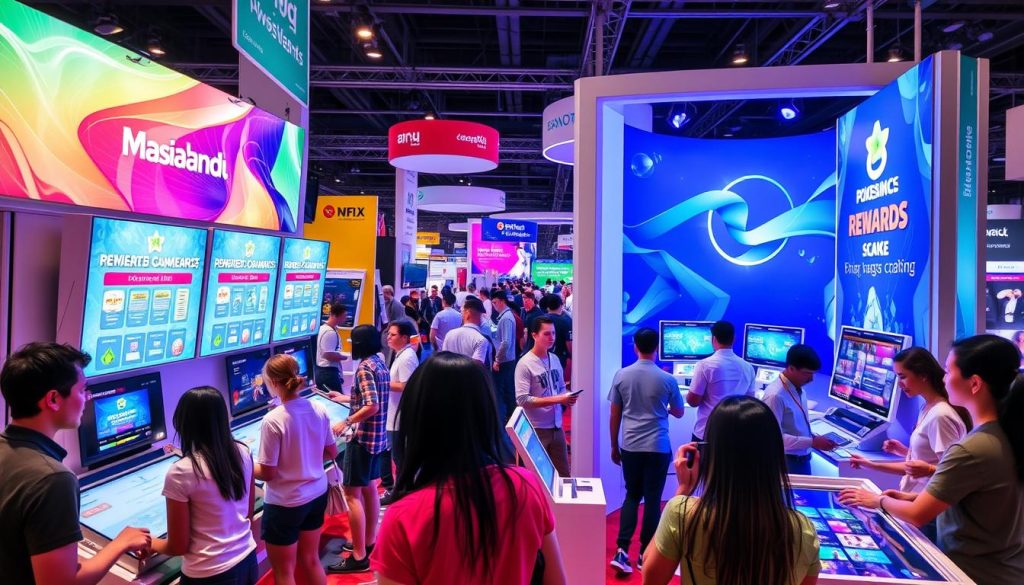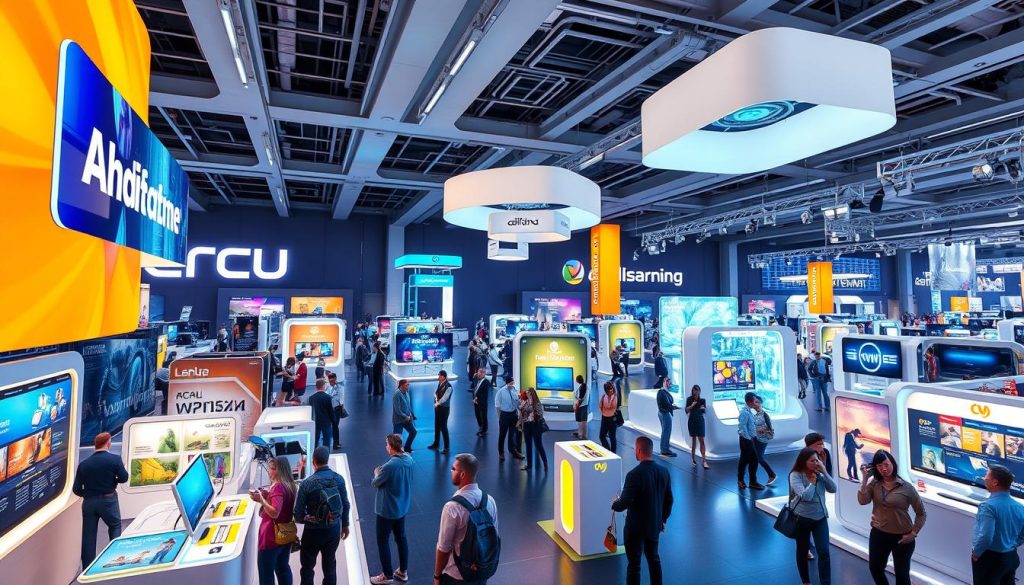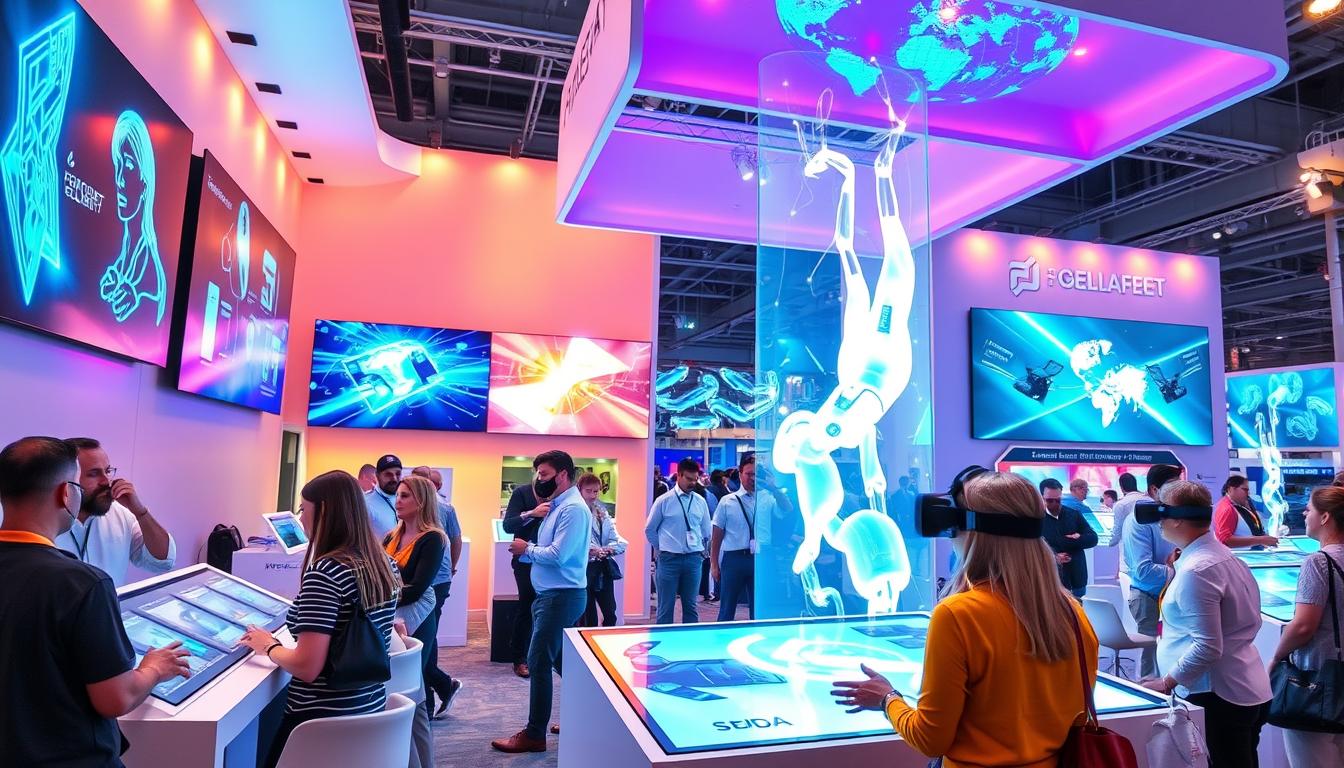Tradeshows have evolved into vibrant hubs of innovation and engagement. Today’s exhibitors are embracing interactive experiences to captivate attendees. Gone are the days of static displays; now, brand engagement takes center stage through gamification strategies and immersive booth designs.
Companies are reimagining their tradeshow presence, creating memorable moments that resonate long after the event ends. By incorporating branded games and digital elements, exhibitors can foster deeper connections with potential clients and partners.
The shift towards interactive marketing has transformed how businesses approach these events. Gamification strategies now play a crucial role in lead generation and data collection. This new landscape offers exciting opportunities for brands to showcase their creativity and tech-savvy nature.
Key Takeaways
- Interactive experiences are reshaping tradeshow marketing
- Gamification strategies enhance visitor engagement
- Brand engagement is key to successful tradeshow presence
- Digital elements create memorable booth experiences
- Innovative approaches lead to better lead generation
Evolution of Tradeshow Marketing in the Digital Age
Tradeshow marketing has transformed dramatically in recent years. Gone are the days of static displays and brochures. Today’s exhibitors focus on creating immersive experiences that captivate attendees and leave lasting impressions.
From Traditional Displays to Interactive Experiences
Modern exhibitor booth attractions go beyond eye-catching banners. They now include touch screens, virtual reality simulations, and interactive product demos. These elements engage visitors on multiple levels, making the brand experience memorable and shareable.
Digital Integration in Modern Exhibits
Digital technology is at the heart of today’s tradeshow marketing. QR codes link to product information, while augmented reality apps bring static displays to life. This fusion of physical and digital creates a seamless, immersive marketing environment that resonates with tech-savvy attendees.
Data-Driven Engagement Strategies
Smart exhibitors use data to refine their visitor retention techniques. By analyzing foot traffic patterns, booth dwell times, and interaction rates, companies can adjust their strategies in real-time. This data-driven approach ensures that every aspect of the booth experience is optimized for maximum engagement.
“The future of tradeshow marketing lies in creating personalized, technology-driven experiences that speak directly to each attendee’s interests and needs.”
As the tradeshow landscape evolves, staying ahead of these trends is crucial. Companies that embrace innovative booth design, digital integration, and data analytics are poised to make the most of their tradeshow investments, turning casual visitors into qualified leads and long-term customers.
The Role of Branded Games in Modern Tradeshow Marketing
Branded games are revolutionizing trade show entertainment. These interactive experiences captivate attendees and boost brand awareness. By blending fun with marketing, companies create memorable moments that stick long after the event ends.
Experiential branding through games offers unique advantages:
- Increased booth traffic
- Extended engagement time
- Data collection opportunities
- Brand message reinforcement
Trade show visitors crave excitement. Branded games deliver just that, turning passive observers into active participants. From virtual reality challenges to digital quizzes, these interactive experiences transform booths into hubs of activity.
One key benefit is lead generation. Games can capture contact info and preferences, feeding valuable data into sales pipelines. This approach proves far more effective than traditional methods.
“Gamification at trade shows can increase lead capture by up to 30%”
To maximize impact, games should align with brand values and target audience interests. A well-designed game can create a landing page-like experience, guiding players through key messaging while entertaining them.
Successful implementation requires careful planning. Companies must consider:
- Game mechanics that resonate with their audience
- Technical requirements for smooth operation
- Staff training to facilitate gameplay
- Integration with broader marketing strategies
When executed well, branded games become powerful tools for experiential branding. They create buzz, foster connections, and leave lasting impressions that translate into tangible business outcomes.
Creating Immersive Booth Experiences
Immersive marketing takes center stage in modern tradeshow booths. Exhibitors now focus on creating memorable experiences that captivate attendees and foster brand engagement. Let’s explore how to design spaces that leave a lasting impression.
Designing Interactive Spaces
Interactive spaces are key exhibitor booth attractions. These areas encourage visitors to engage with your brand hands-on. Consider touchscreen displays, virtual reality stations, or interactive product demos. Cold email marketing can be used to invite potential clients to your interactive booth beforehand.
Incorporating Multi-Sensory Elements
Engage all five senses to create a truly immersive experience:
- Sight: Use eye-catching visuals and lighting
- Sound: Play brand-specific audio or ambient noise
- Touch: Offer tactile experiences with products
- Smell: Use subtle scents to enhance mood
- Taste: Provide branded snacks or beverages
Leveraging Technology for Engagement
Technology plays a crucial role in modern booth design. Augmented reality (AR) apps can bring products to life. Social media walls display real-time posts about your brand. RFID badges track visitor engagement and provide personalized experiences.
Effective immersive marketing creates a seamless blend of physical and digital elements. This approach not only attracts visitors but also creates memorable experiences that lead to increased brand engagement and potential sales.
| Element | Impact on Visitor Experience | Potential ROI |
|---|---|---|
| Interactive Displays | High engagement, longer booth visits | Increased lead quality |
| Multi-Sensory Design | Memorable brand experience | Enhanced brand recall |
| AR/VR Technology | Immersive product demonstrations | Higher conversion rates |
By focusing on these elements, exhibitors can create booth experiences that stand out on the tradeshow floor. Remember, the goal is to create an environment where visitors don’t just see your brand – they experience it. Collecting reviews post-event can help measure the success of your immersive booth strategy.
Gamification Strategies for Lead Generation
Tradeshow success hinges on effective lead generation tactics. Gamification strategies have emerged as powerful tools to captivate attendees and boost visitor retention techniques. By turning booth interactions into engaging experiences, exhibitors can significantly increase their lead capture rates.

One popular approach involves digital quizzes or trivia games related to your industry. These not only educate visitors but also collect valuable contact information. Another effective method is the use of virtual scratch cards or spin-the-wheel games, offering prizes or discounts to participants who provide their details.
Leaderboards can spark friendly competition among attendees, encouraging repeat visits to your booth. This lead generation tactic keeps visitors engaged throughout the event, maximizing opportunities for meaningful conversations.
Interactive product demonstrations gamified with augmented reality create memorable experiences. Visitors can explore features, compete in challenges, and earn points redeemable for merchandise or consultations. This approach not only showcases your offerings but also gathers crucial data on prospect interests.
| Gamification Strategy | Lead Generation Impact | Visitor Retention Rate |
|---|---|---|
| Digital Quizzes | 25% increase | 40% higher |
| Virtual Scratch Cards | 30% increase | 35% higher |
| AR Product Demos | 40% increase | 50% higher |
By integrating these gamification strategies into your tradeshow marketing plan, you can create a dynamic, interactive environment that not only attracts more leads but also enhances the overall quality of your connections.
Measuring ROI in Modern Tradeshow Marketing
Tradeshow success hinges on measuring return on investment. Brand engagement and lead generation tactics form the backbone of modern tradeshow strategies. Let’s explore key metrics and tools for tracking performance.
Key Performance Indicators
Effective ROI measurement starts with identifying the right KPIs. These metrics help gauge the impact of your tradeshow efforts:
- Booth traffic
- Lead quality and quantity
- Social media mentions
- Sales pipeline growth
Analytics Tools and Tracking
Data-driven engagement strategies rely on robust analytics. Cold email marketing experts use similar tools to track campaign performance. For tradeshows, consider:
| Tool | Purpose |
|---|---|
| CRM software | Lead tracking and follow-up |
| Badge scanners | Visitor data collection |
| Social listening platforms | Monitor online buzz |
Converting Engagement to Sales
The ultimate goal is turning interactions into revenue. Implement these strategies:
- Segment leads based on interest level
- Create targeted follow-up campaigns
- Use personalized content to nurture prospects
By focusing on these aspects, you’ll transform your tradeshow presence from a cost center to a profit generator. Remember, consistent tracking and analysis are key to refining your approach and maximizing returns.
Virtual and Hybrid Tradeshow Solutions

The tradeshow landscape is evolving rapidly, with virtual and hybrid events becoming increasingly popular. These new formats offer unique opportunities for digital integration and immersive marketing experiences. Companies can now reach global audiences without geographical limitations, creating interactive experiences that blend the best of physical and digital worlds.
Virtual tradeshows leverage cutting-edge technology to simulate real-world exhibitions. Attendees navigate 3D environments, interact with virtual booths, and engage in live chat sessions with exhibitors. This digital integration allows for seamless data collection and personalized follow-ups, enhancing lead generation efforts.
Hybrid events combine in-person and online elements, offering flexibility for both exhibitors and attendees. These solutions provide immersive marketing opportunities through augmented reality (AR) and virtual reality (VR) experiences. For example, on-site visitors can use AR apps to view product demos, while remote participants enjoy virtual tours of the exhibition hall.
“Virtual and hybrid tradeshows are not just a trend, but a transformation in how we connect and do business globally.”
The benefits of these innovative solutions include:
- Expanded reach and accessibility
- Cost-effective participation
- Enhanced data analytics
- Sustainable event practices
- Year-round engagement opportunities
| Feature | Virtual Tradeshows | Hybrid Tradeshows |
|---|---|---|
| Audience Reach | Global | Local + Global |
| Interactive Experiences | Fully Digital | Physical + Digital |
| Networking Opportunities | Virtual Meetings | In-person + Virtual |
| Content Accessibility | On-demand | Live + On-demand |
| Cost | Lower | Moderate |
As technology advances, we can expect even more innovative and engaging virtual and hybrid tradeshow solutions, further revolutionizing the industry and creating new opportunities for businesses to connect with their target audiences.
Sustainable Practices in Exhibition Design
Modern tradeshow marketing is embracing eco-friendly approaches, transforming exhibitor booth attractions into showcases of sustainability. This shift aligns with growing environmental awareness and corporate responsibility.
Eco-Friendly Materials
Experiential branding now incorporates sustainable materials in booth design. Bamboo, recycled plastics, and biodegradable fabrics are popular choices. These materials reduce environmental impact without compromising visual appeal or durability.
Reusable Display Elements
Tradeshow marketers are adopting modular designs for exhibits. These versatile components can be reconfigured for different events, cutting waste and costs. Reusable displays also streamline setup and teardown processes, enhancing efficiency.
Green Technology Integration
Innovative tech is powering sustainable booth experiences. LED lighting, solar panels, and energy-efficient devices are becoming standard. These technologies not only reduce energy consumption but also serve as talking points, demonstrating a brand’s commitment to sustainability.
By embracing these practices, companies are creating exhibitor booth attractions that resonate with environmentally conscious attendees. This approach to modern tradeshow marketing not only reduces ecological footprint but also enhances brand image and visitor engagement.
“Sustainable design is no longer a choice, it’s a necessity in today’s exhibition landscape.”
As the industry evolves, these green practices are setting new standards for tradeshow excellence, proving that sustainability and impactful marketing can go hand in hand.
Social Media Integration and Amplification
Social media plays a crucial role in modern tradeshow marketing. It’s a powerful tool for brand engagement and creating interactive experiences that last beyond the event itself. Smart exhibitors use social platforms to build buzz, connect with attendees, and showcase their products in real-time.
One effective strategy is to create a unique event hashtag. This allows attendees to share their experiences and engage with your brand online. Live-streaming booth activities or product demos can also draw virtual audiences, expanding your reach far beyond the physical event space.
Visitor retention techniques on social media can include:
- Running contests or giveaways
- Sharing behind-the-scenes content
- Posting real-time updates and highlights
- Encouraging user-generated content
These strategies keep attendees engaged and encourage them to revisit your booth or follow up post-event. Interactive experiences like AR filters or virtual photo booths tied to your brand can also boost engagement and create shareable moments.
| Platform | Best Practices | Engagement Metrics |
|---|---|---|
| Use Stories for live updates, create branded AR filters | Story views, filter usage, hashtag mentions | |
| Live-tweet event highlights, host Q&A sessions | Retweets, replies, hashtag reach | |
| Share industry insights, connect with professionals | Post engagement, new connections, lead quality |
By integrating social media effectively, exhibitors can create a seamless blend of physical and digital experiences, enhancing their tradeshow presence and extending their reach far beyond the event floor.
Building Post-Show Engagement Strategies
The end of a tradeshow marks the beginning of crucial lead generation tactics. Successful exhibitors understand that brand engagement extends far beyond the event itself. By implementing smart post-show strategies, companies can maximize their tradeshow investment and turn leads into loyal customers.
Follow-up Campaigns
Timely follow-ups are key to maintaining momentum. Personalized emails, phone calls, or even direct mail can keep your brand fresh in prospects’ minds. Craft messages that reference specific conversations or demonstrations from the show to create a lasting connection.
Content Repurposing
Transform your tradeshow presence into valuable content. Turn booth presentations into webinars, create blog posts from frequently asked questions, or develop case studies featuring success stories shared at the event. This approach extends the life of your tradeshow materials and supports ongoing experiential branding efforts.
Community Building
Foster a sense of community among your new contacts. Consider creating an exclusive online group or forum where attendees can continue discussions started at the show. Regular webinars or virtual meetups can strengthen relationships and position your brand as an industry leader.
- Share behind-the-scenes content from the tradeshow
- Offer special post-show promotions to attendees
- Invite top prospects to beta test new products or services
By focusing on these post-show engagement strategies, companies can transform brief tradeshow interactions into long-term business relationships. Remember, the goal is to provide ongoing value that reinforces your brand’s commitment to customer success.
Conclusion
Modern tradeshow marketing has transformed into a dynamic, engaging experience. Branded games and interactive experiences now take center stage, captivating attendees and creating lasting impressions. These innovative approaches have revolutionized how brands connect with potential clients at exhibitions.
The shift towards digital integration and immersive booth designs has opened new avenues for lead generation and brand awareness. By incorporating multi-sensory elements and leveraging cutting-edge technology, companies can create memorable experiences that resonate long after the event ends.
As we look to the future of tradeshow marketing, the focus remains on creating meaningful interactions. Whether through virtual platforms or in-person events, the key lies in crafting experiences that inform, engage, and inspire. By embracing these trends, brands can maximize their tradeshow presence and drive tangible business results in today’s competitive landscape.
FAQ
What are branded games in tradeshow marketing?
Branded games in tradeshow marketing are interactive experiences designed to engage attendees, enhance brand awareness, and generate leads. These games incorporate a company’s branding elements and often use gamification strategies to create memorable and immersive experiences at exhibitor booths.
How do branded games contribute to lead generation?
Branded games contribute to lead generation by attracting visitors to exhibitor booths, encouraging participation, and collecting valuable data. They often require players to provide contact information or answer survey questions, creating opportunities for follow-up and nurturing potential leads after the event.
What types of branded games work well at tradeshows?
Effective branded games at tradeshows include interactive quizzes, virtual reality experiences, augmented reality games, digital prize wheels, and touchscreen challenges. The best games align with the brand’s messaging, are easy to understand, and provide a fun, engaging experience for attendees.
How can exhibitors measure the success of their branded games?
Exhibitors can measure the success of branded games by tracking key performance indicators such as the number of participants, leads generated, dwell time at the booth, and social media mentions. Advanced analytics tools can also provide insights into user engagement and behavior during the game.
Are branded games effective in virtual or hybrid tradeshow formats?
Yes, branded games can be highly effective in virtual or hybrid tradeshow formats. Digital games can be easily adapted for online platforms, providing interactive experiences that engage remote attendees and create memorable brand interactions, even without physical presence.
How do branded games enhance visitor retention at tradeshows?
Branded games enhance visitor retention by creating engaging and memorable experiences that encourage attendees to spend more time at an exhibitor’s booth. The interactive nature of games helps to break the ice, facilitates conversations, and makes the brand more memorable, increasing the likelihood of post-show follow-ups.
What role does social media play in branded game strategies?
Social media plays a crucial role in branded game strategies by amplifying reach and engagement. Games can be designed to encourage social sharing, such as posting high scores or unique experiences. This extends the game’s impact beyond the tradeshow floor and increases brand visibility.
How can exhibitors ensure their branded games align with their overall marketing strategy?
To align branded games with overall marketing strategy, exhibitors should ensure the game’s theme, messaging, and rewards reflect the brand’s values and objectives. The game should reinforce key product features or brand messages and collect data that supports broader marketing goals.
What are some best practices for designing branded games for tradeshows?
Best practices for designing branded games include keeping rules simple, ensuring quick gameplay to accommodate booth traffic, incorporating clear branding elements, offering meaningful prizes or incentives, and designing for easy setup and maintenance during the event. The game should also be accessible to a wide range of attendees.
How can branded games be integrated into post-show engagement strategies?
Branded games can be integrated into post-show engagement strategies by repurposing game content for follow-up campaigns, extending online versions of the game for continued play, and using game data to personalize follow-up communications. This helps maintain the connection established at the tradeshow and nurtures leads over time.


